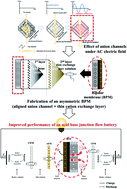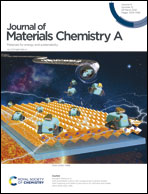High performance acid–base junction flow batteries using an asymmetric bipolar membrane with an ion-channel aligned anion exchange layer†
Abstract
An acid–base junction flow battery (ABJFB) is a new type of energy conversion system using neutralization and water dissociation in the presence of acid and base electrolytes. The bipolar membrane (BPM) is a core component in determining the performance of the ABJFB. In particular, the development of an anion exchange layer (AEL) is essential to improve the performance of the BPM. In the present study, we fabricated a novel BPM composed of aligned ion channels of a quaternary aminated poly (2,6-dimethyl-1,4-phenylene oxide) (QPPO) layer and a pellicle of the cation exchange layer (CEL). The results showed that the through-plane conductivity of the QPPO membrane prepared under an AC electric field improved from 26.78 to 120.83 mS cm−1, owing to the aligned ion channels. The fabricated BPM based on the aligned QPPO membrane showed the remarkably improved performance of water dissociation and neutralization reactions in the presence of acid and base electrolytes without delamination. The ABJFB assembled with the optimized BPM showed a high power density of 3.85 mW cm−2 under a high strength acid/base of 2 N H2SO4 and NaOH solutions. In addition, we first performed a long-term operation of 60 cycles with a high coulombic efficiency of 98.9%, energy efficiency of 55.5%, and voltage efficiency of 56.1% under 2 N H2SO4 and NaOH at a high current density of 4 mA cm−2.



 Please wait while we load your content...
Please wait while we load your content...